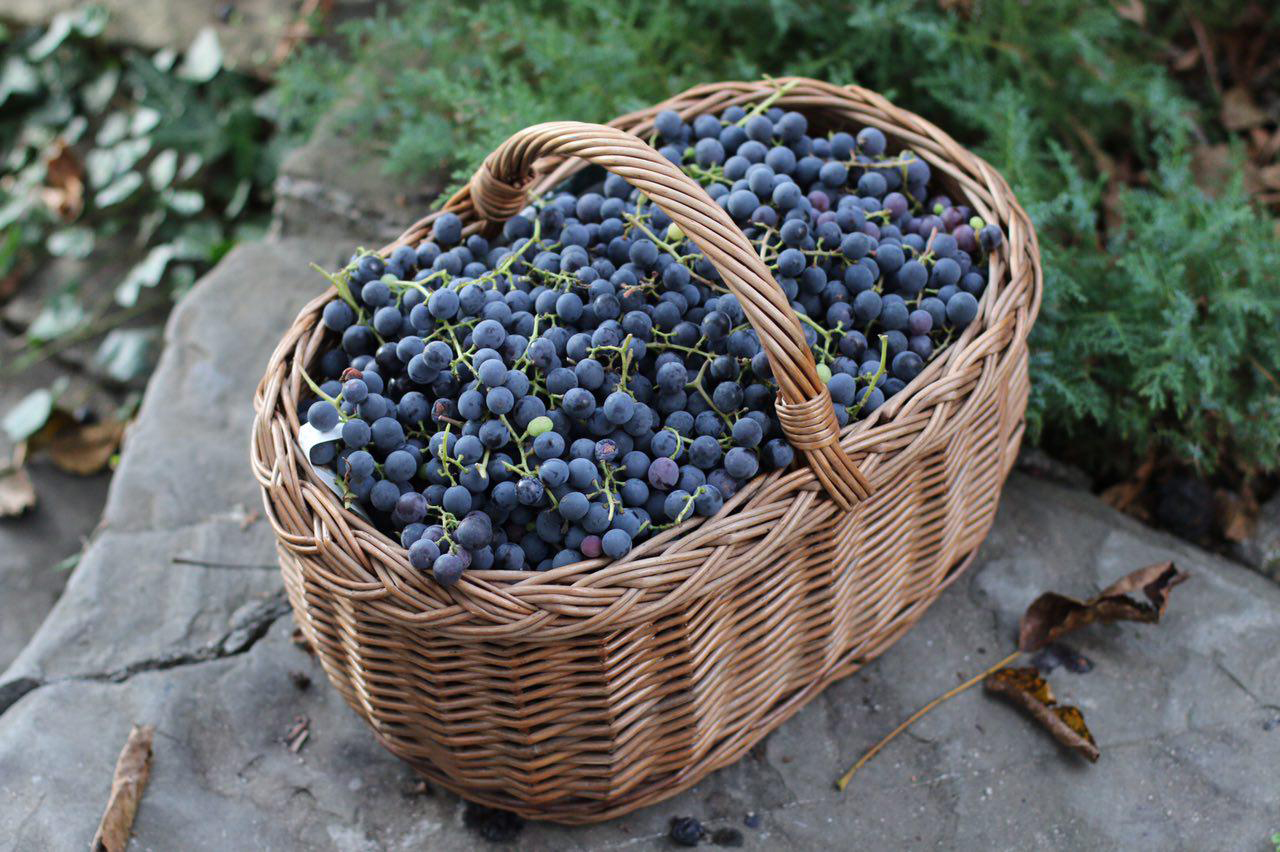
The Isabella grape variety is popular among wine growers in central Russia. An unpretentious plant successfully adapts to a difficult climate for it, gives excellent harvests.
At the same time, in the south, Isabella is grown less often, preferring fruitful sweet varietal species.
Content
History of Isabella
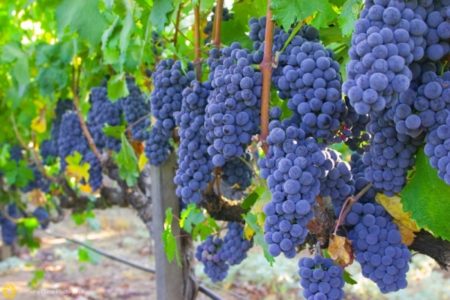
A wonderful variety appeared in America; nature itself acted as a breeder. A view with incredibly fragrant clusters was discovered by W. Prince, an American winegrower. It was at the beginning of the 19th century, and the variety was named in honor of the wife of the owner of the Long Island territories, Isabella Gibbs.
In the middle of the last century, Isabella was brought to the republics of the USSR, where grapes were loved for their unpretentiousness, resistance to infections, and excellent yield indicators. It turned out that berries are an excellent raw material for wine, tinctures, juice.
Isabella grows in private vineyards throughout the former Soviet Union, and it is grown in Russia, starting from the south and ending with Siberia, the Northwest, and the Urals.
Grade description
The plant is powerful, with thick strong shoots. It forms few stepsons, the vine grows slowly over 5-8 years. Then comes a period of rapid growth, when each year the shoots increase in length by 2-4 meters.
At an early age, the shoots are green, with a dull raspberry brown hue. Later, the color changes to a dark gray color with a brown tint. Leaflets whole or slightly dissected, dark green. The underside of the leaf blade is gray.
Universal grade:
- suitable for making wines and tinctures;
- used as a dessert;
- used for making juice, compotes.
It ripens late, the growing season is 5-6 months. It gives the first harvest 3-4 years after disembarkation. Winter-resistant bushes withstand frosts to minus 32-35 degrees with shelter, survive the winter without protection at minus 24-28 degrees.
Fruit characterization
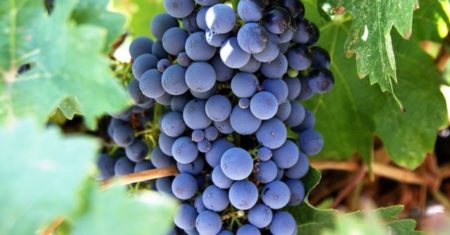
Winegrowers celebrate Isabella's high yields. In this grape, 3-5 berry clusters are simultaneously formed on each shoot.
Conical brushes with one wing. Grones are loose, the weight of each is 180-250 grams. The berries are rounded, dark blue, sometimes purple. A dense coating is clearly visible on a strong and dense skin. The diameter of the berries is 1.5-2 cm. By weight - 2-3 grams. Inside there are few seeds, the pulp is jelly-like, sour-sweet taste.
There is a pronounced aroma of garden strawberries. The taste in food is a peculiar one, peculiar only to Isabella. Winemakers in Europe consider this type not suitable for the production of quality drinks because of the flavor. At the same time, in the CIS countries, in Russia, in Australia, on the American continent, Isabella is on the top list of varieties used in winemaking.
Advantages and disadvantages
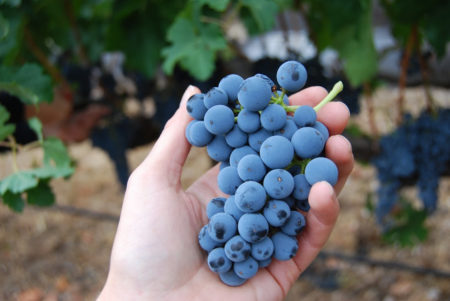
Gardeners and winemakers argue about Isabella constantly, proving their opponents' attractiveness, the benefits of grapes or vice versa, convincing of a large number of shortcomings.
Advantages:
- ease of cultivation;
- high frost resistance;
- rapid growth of shoots if the bush was damaged by spring frosts;
- the possibility of breeding by cuttings;
- withstand waterlogging of the soil;
- possesses excellent immunity;
- seldom affected by disease;
- Isabella's ripe berries are not interesting to wasps and birds;
- low calorie content (per 100 grams - 65 calories);
- berries do not cause allergies.
Isabella grows and bears fruit in regions where traditional grape varieties are not even tried to grow. With mixed plantings in case of the appearance of diseases on other varieties, this beauty steadily withstands the attack of pathogens of infections and is not affected by diseases. The grapes are not afraid of oidium, mildew, gray rot, which greatly simplifies the care and avoids losses in yield.
Technical grade is ideal for the decoration of the site. Isabella is planted in gazebos, near arches, barriers, fences. The plant looks spectacular on the territory, so grape bushes are used in landscape design.
Isabella is willingly grown by ordinary winegrowers, using berries to make homemade wines, tinctures, and juices. The variety is considered one of the best commercial types of grapes in Moldova, Azerbaijan.
Disadvantages:
- Isabella is prone to anthracnosis;
- does not tolerate acidic soils, but for the deoxidation of soil can not be used fluff;
- demanding on moisture, reduces productivity even with small droughts;
- the presence of a specific taste.
When planting seedlings on acidified soils, the soil is pre-cultivated, introducing dolomite flour, wood ash. Regulate indicators of soil moisture, preventing overdrying of the soil.
It is more difficult with a taste, since not everyone likes the presence of a foxy (fox) shade in the berries. It appears due to acetophenone and special essential oils contained in the skin of grapes. Because of it, wines from Isabella over three years of age have a specific sharp aroma that worsens the overall bouquet of the drink. Therefore, isabel wines are recommended to be stored for no more than three years.
Features of agricultural technology
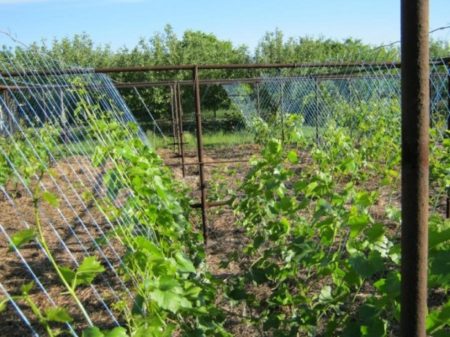
Undemanding Isabella is cultivated in different regions, taking into account some features of the variety when leaving.
Selection of seedlings
For planting, buy annual shoots, at least 20-30 cm long. The number of roots is 3-4 pieces, the length is 10-12 cm. Plants with spots and deformations on the stems, with blackened roots are unsuitable. It is recommended to buy seedlings in nurseries, farms.
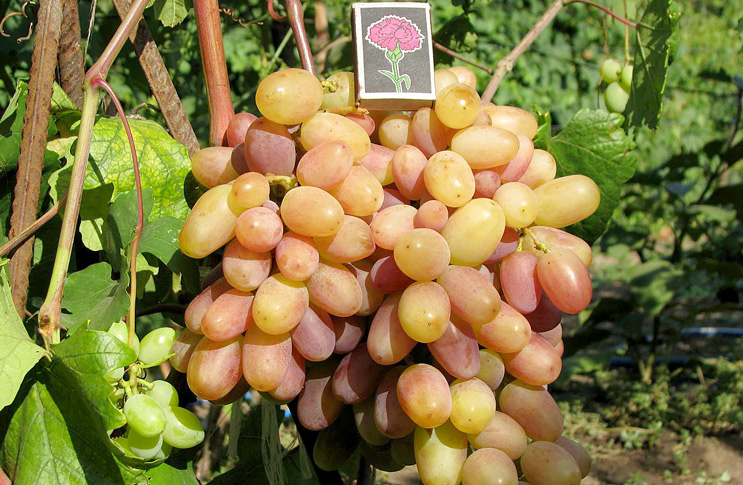
Grapes Victor: characteristics and description of the variety, planting and care
The pride of Russian grape selection is considered to be Victor. He is considered a novelty, but has already managed to acquire an army ...
Landing
It is advisable to plan a landing in the fall, while taking into account the climate of the region, the weather conditions of a particular season. The best time is the beginning of September, so that the seedlings have time to adapt and take root in a new place.
In the middle lane and to the north, as well as in Siberia, in the Urals, spring planting is more often practiced. The winter season with colds begins in these areas suddenly, so in order not to ruin the grapes, it is advisable to transfer the work to spring.
Suitable soil is fertile, with low acidity, although Isabella successfully adapts to sandstones, loams. Landing location - free space to the west or south.
Landing pits are prepared in advance, diameter - 80-90 cm, depth - up to a meter. During spring planting, holes are dug in the fall, adding drainage to the bottom (pebbles, gravel), then nutrient soil with fertilizers with a layer of 10-15 cm. The contents are carefully shed with water.
Roots (3-4 cm) are cut in seedlings, soaked in growth stimulants, and disinfected in a pink solution of potassium permanganate. Before planting, dip the roots into a special mash of clay and mullein, then leave seedlings to dry the mixture.
A stake is set in the hole, the bush is carefully placed in the middle on the knoll, the roots are straightened. Sprinkle with earth, not allowing the deepening of the place where the shoots start letting out twigs.
Stems are shortened by 4-5 buds from above, tied to a peg, well shed watered. So that the bright rays of the sun do not burn the plant, cover the bushes with non-woven material.
The distance between several seedlings is 1.5 m, in the rows - up to 2-3 meters. Set trellis, pulling a wire between the massive supports.
Further care
Isabella is a capricious grape, but still should not be left without planting.
Top dressing
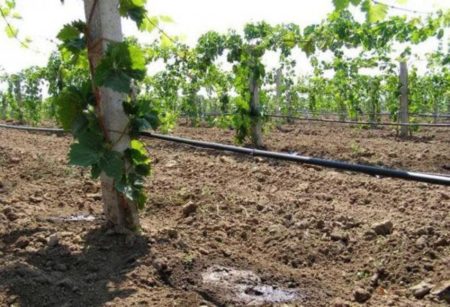
The variety yields crops on fertile lands, so the gardener needs to plan ahead in advance a fertilizer schedule. The total number of top dressings is 3-4 times during the time from spring to autumn. As an addition, organic matter (compost, humus) is added, at least every 2-3 years.
Approximate feeding scheme:
- In the spring, grape bushes are watered with formulations with nitrogen-containing fertilizers: ammonium sulfate or urea (diluted according to instructions). From organics fit herbal infusions: comfrey, dandelion, nettle. Isabella responds well to watering with bird droppings infusion.
- The second top dressing during the setting of berries. Use compounds with superphosphate (40 grams per bucket of water), wood ash (three liters of ash per three hot water), kalimagnesia (25-30 grams per bucket of water).
- After collecting the berries, in the fall make compositions containing a complex of various substances: Kemira-Lux, Floravit.
- It is useful to spray the bushes with a solution of magnesium sulfate (1-2 times per summer).
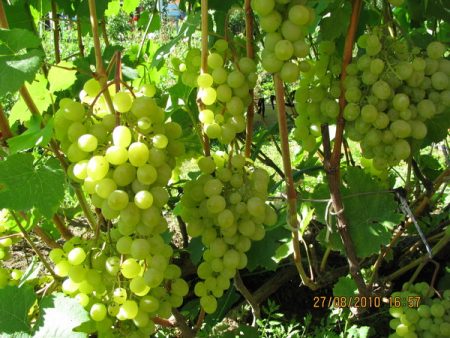
Planting and grape care in the suburbs
Successful cultivation of grapes in the suburbs is possible and this was proved several centuries ago. It was in the 17th century in ...
Watering
Irrigation regime is determined by the type of soil, age of the bushes, weather conditions. Loam requires rare but saturated watering. Moderate and frequent watering is practiced on sandstone and black soil.
Most moisture is required to the bushes up to 2-3 years, then the plants are less demanding on moisture. But it is unacceptable to forget about regular watering, since Isabella immediately discards the ovaries or gives small tasteless berries.
The young vine is watered every 7-10 days, spending 2 buckets of water per 1 square meter. The norm is maintained for adult plants, but irrigation is carried out less often, about once every 20-25 days.
Watering is reduced and completely stopped in mid-August, when the berries get the inherent bluish color of the variety. After harvesting, after 14-18 days carry out water-charging irrigation. Up to 8 buckets of water are consumed per adult bush.
It is recommended to water Isabella through the drip irrigation system or using pipes. Also watered bushes in trenches, grooves in the aisles. Exclude moisture on the leaves of the vineyard.
Bushes
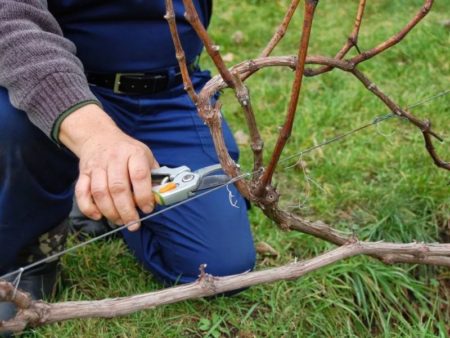
The main procedure is planned for the fall, as with spring pruning, there is a high risk of copious release of juice. The liquid fills the eyes of the bushes, they rot, do not bloom.
In autumn, all sick and weak stepsons are cut off, the new year’s growth is cut by 1/3, lignified shoots by 2/3. Isabella is a full-grown grape variety; without pruning and forming, the bushes thicken.
In addition to autumn, spend spring a little cropping and summer. During these procedures, extra leaves are removed, branches growing down, thickening shoots.
Thinning Isabella clusters are practiced, leaving 25-30 brushes on each bush. The formation of bushes begins only in the second year, tying the vine to trellis with a bend. It is recommended to use rags to lay so that the vine does not fray with wire. The task of the grower: to make the bush branch to the sides, and not grow only up.
Wintering
They cover Isabella only in regions with a harsh climate. In the middle lane it is also recommended to cover the bushes, the winter season is too unpredictable here. The technical variety is included in the group of non-covering species, but for reinsurance it is still better to protect the bushes from frost.
After harvesting, the vine is removed from the trellis, laid on the ground or prepared grooves. Sprinkle with peat crumbs, foliage, conifers. Next, a layer of covering material is laid.
After the snow falls, a snowdrift is created, during the winter regularly adding snow. In the spring, with the onset of stable heat, the shelter is removed. To avoid the risk of freezing, the bushes are sprayed with Epin.
Pest and Disease Control
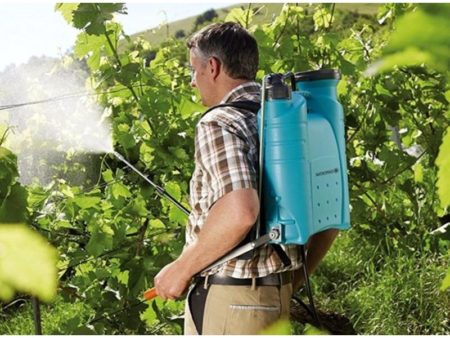
Isabella is suitable for growing novice growers. The variety does not need numerous treatments, as it rarely gets sick, does not suffer from pest attacks. Fears are caused by anthracnose, which, if untreated, quickly spreads through the plantings.
Prevention:
- Spraying with Bordeaux liquid (in the spring 1-2 times);
- Treatment with Skor, Topaz and similar drugs (several times during the season).
The compositions alternate so that there is no addiction.
From pests, it is enough to spray the bushes in the spring with Nitrofen. It is useful to treat the vineyard with a solution of soda ash. To protect against birds in the fall, nets are used, non-woven thin materials that transmit light and air.
Isabella grape variety deserves the attention of gardeners. Unpretentious, productive grapes will give delicious berries, while it will require a minimum of care and hassle.
Reviews
Catherine, Penza
I’ve been growing only Isabella for ten years now. We are satisfied, as we get the crop every year, regardless of the weather. Sometimes it is smaller, but most often it bears fruit abundantly. For any newfangled hybrids this proven variety will not be exchanged.
Ivan, Elektrostal
I have 8 varieties on the plot, and Isabella is among my favorites. Gives the berries from which I make wine, compotes. Grandchildren love Isabella for taste, they say, wine berry. I appreciate the variety for a very simple care. For winter, the only variety that I can’t cover. And it grows near the gazebo, withstands even cold winters.

 Non-covering winter-hardy grape varieties for Moscow region
Non-covering winter-hardy grape varieties for Moscow region How to keep the vine in winter
How to keep the vine in winter When can I transfer grapes to another place in the fall
When can I transfer grapes to another place in the fall How to cover and prepare grapes for the winter in the suburbs
How to cover and prepare grapes for the winter in the suburbs